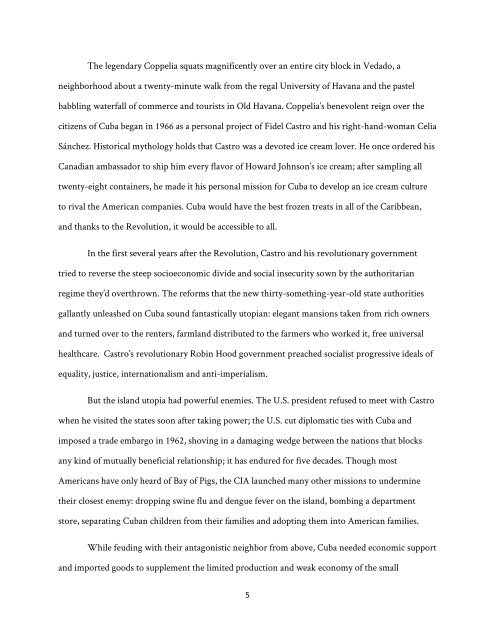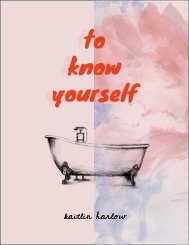Create successful ePaper yourself
Turn your PDF publications into a flip-book with our unique Google optimized e-Paper software.
The legendary Coppelia squats magnif<strong>ice</strong>ntly over an entire city block in Vedado, a<br />
neighborhood about a twenty-minute walk from the regal University of Havana and the pastel<br />
babbling waterfall of commerce and tourists in Old Havana. Coppelia’s benevolent reign over the<br />
citizens of Cuba began in 1966 as a personal project of Fidel Castro and his right-hand-woman Celia<br />
Sánchez. Historical mythology holds that Castro was a devoted <strong>ice</strong> <strong>cream</strong> lover. He once ordered his<br />
Canadian ambassador to ship him every flavor of Howard Johnson’s <strong>ice</strong> <strong>cream</strong>; after sampling all<br />
twenty-eight containers, he made it his personal mission <strong>for</strong> Cuba to develop an <strong>ice</strong> <strong>cream</strong> culture<br />
to rival the American companies. Cuba would have the best frozen treats in all of the Caribbean,<br />
and thanks to the Revolution, it would be accessible to all.<br />
In the first several years after the Revolution, Castro and his revolutionary government<br />
tried to reverse the steep socioeconomic divide and social insecurity sown by the authoritarian<br />
regime they’d overthrown. The re<strong>for</strong>ms that the new thirty-something-year-old state authorities<br />
gallantly unleashed on Cuba sound fantastically utopian: elegant mansions taken from rich owners<br />
and turned over to the renters, farmland distributed to the farmers who worked it, free universal<br />
healthcare. Castro’s revolutionary Robin Hood government preached socialist progressive ideals of<br />
equality, just<strong>ice</strong>, internationalism and anti-imperialism.<br />
But the island utopia had powerful enemies. The U.S. president refused to meet with Castro<br />
when he visited the states soon after taking power; the U.S. cut diplomatic ties with Cuba and<br />
imposed a trade embargo in 1962, shoving in a damaging wedge between the nations that blocks<br />
any kind of mutually beneficial relationship; it has endured <strong>for</strong> five decades. Though most<br />
Americans have only heard of Bay of Pigs, the CIA launched many other missions to undermine<br />
their closest enemy: dropping swine flu and dengue fever on the island, bombing a department<br />
store, separating Cuban children from their families and adopting them into American families.<br />
While feuding with their antagonistic neighbor from above, Cuba needed economic support<br />
and imported goods to supplement the limited production and weak economy of the small<br />
5





